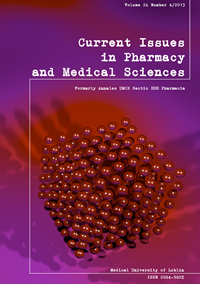Sialylation status of leukocyte cell-surface glycoconjugates in streptozotocin-induced diabetic rats and after treatment with agmatine
DOI:
https://doi.org/10.12923/j.2084-980X/26.4/a.08Keywords:
experimental diabetes mellitus, leukocyte, membrane glycoconjugates, sialic acid, agmatineAbstract
Development of experimental diabetes mellitus in rats was accompanied by increase of desialylation of carbohydrate determinants of leukocyte membrane glycoproteins. A decreased level of both α (2,3)- and α(2,6)-linked sialic acid residues and uncovering the penultimate galactose residues was shown. Our findings shown increase in sialation (in particular α(2,3) sialation) of oligosaccharide sequences of leukocytes membrane glycoconjugates after treatment diabetic rats with agmatine. Detected changes in configuration of leukocyte membrane components in diabetic animals after agmatine administration indicate the positively effects of this polyamine due to its hypoglycemic effect.
References
1. Byrne B, Donohoe G.G., O’Kennedy R. Sialic acids: carbohydrate moieties that influence the biological and physical properties of biopharmaceutical proteins and living cells Drug Discovery Today.,12(7/8):319, .2007
2. Chibber R. Et al.: Leukocytes in diabetic retinopathy Curr. Diabetes Rev., 3(1), 3, 2007.
3. Jou S.B., Liu I.M., Cheng J.T. Activation of imidazoline receptor by agmatine to lower plasma glucose in streptozotocin-induced diabetic rats Neurosci. Lett., 358(2), 111, 2004.
4. Meesmann H.M. et al.: Decrease of sialic acid residues as an eat-me signal on the surface of apoptotic lymphocytes J. Cell Sci., 123 (Pt 19), 3347, 2010.
5. Nan X.,Carubelli I., Stamatos N.M. Sialidase expression in activated human T lymphocytes influences production of IFN-gamma J. Leukoc. Biol., 81(1), 284, 2007.
6. Schauer R. Sialic acids as regulators of molecular and cellular interactions Curr. Opin. Struct. Biol., 19(5), 507, 2009.
7. Stamatos N.M. et al.: Desialylation of glycoconjugates on the surface of monocytes activates the extracellular signal-related kinases ERK ½ and results in enhanced production of specific cytokines J. Leukoc. Biol., 75(2), 307, 2004.
8. Warren L.The thiobarbituric acid assay of sialic acids J. Biol. Chem., 234, 1971, 1959.
9. Zarbock A. Et al.: Leukocyte ligands for endothelial selectins: specialized glycoconjugates that mediate rolling and signaling under flow Blood., 118(26), 6743, 2011.
Downloads
Published
Issue
Section
License
Copyright (c) 2013 Authors

This work is licensed under a Creative Commons Attribution-NonCommercial-NoDerivatives 3.0 Unported License.


